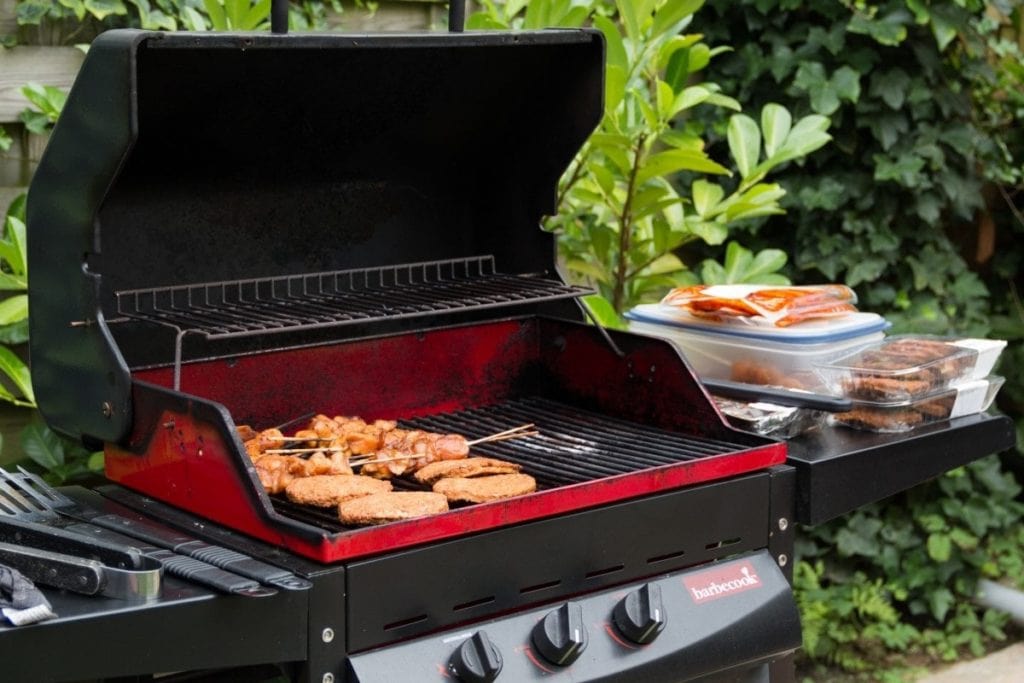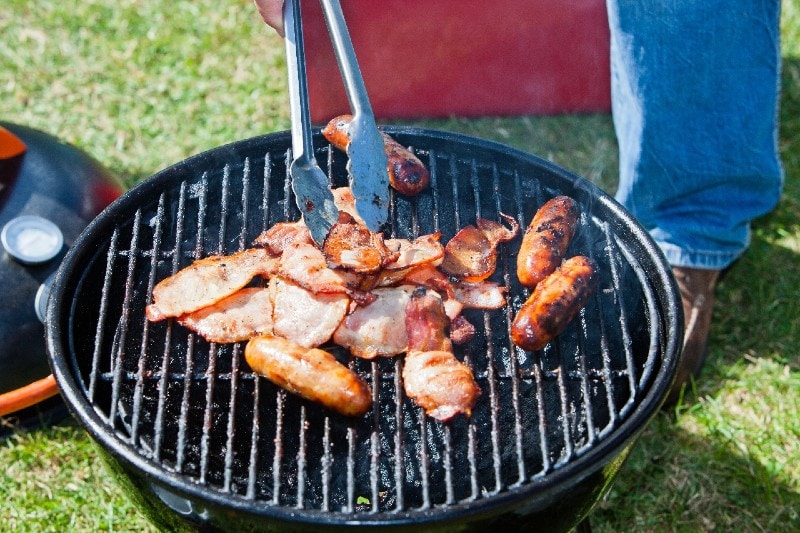Who Invented BBQ? The Fascinating Answer!
-
- Last updated:

It’s hard to imagine someone in the US that hasn’t tried barbeque at least once in their lives. It’s a big part of American culture. But when were the BBQ grills invented? The word “barbacoa” was first used by Gonzalo Oviedo in 1526 to describe the slow cooking technique used by the Taínos in the Caribbean. Four centuries later, in 1952, George Stephen invented the modern-day barbeque device.
The next breakthrough happened in the 90s when the George Foreman grills were introduced. To this day, they are incredibly popular. It all started way before Native American tribes, though. Our ancestors have been cooking meat for millions of years! Eager to learn more about BBQs? Let’s dive right in!
What Is a BBQ? What Does It Stand For?
Before we dive head-first into the history of barbeque, let’s answer the most popular question online: why is it called BBQ? Well, there’s no great mystery here. BBQ stands for barbeque—it’s an abbreviation, a slightly unusual one. This term is widely used not only in the States but also in Canada and the UK. The Australians have a different word for it, Barbie.
In South Africa, you’ll hear folks call it a braai. So, is a BBQ the cooking technique or a device you use to grill the meat? It’s both! In fact, BBQ describes not only the meals or the appliances that do the grilling but also outdoor gatherings at which the meat is prepared and served. That’s right: a barbeque is more than just a meal or an apparatus for cooking it.

Homo Erectus Cooking Techniques
Approximately 2.5 million years ago, Earth underwent a major climate shift and became much hotter and drier. That forced our ancestors to switch from fruits, flowers, seeds, and bark (their regular diet) to meat. Why do that, though? Higher temps and low humidity levels killed most of the green plants, making ancient people starve.
Therefore, they had to look for new sources of nutrients like animal flesh. Unlike seeds and fruits, the animals fought back, but killing them was the only way to survive. So, when did our ancestors learn how to cook? It’s believed that we mastered the art of grilling raw meat between 1.8 million and 400,000 years ago. Most historians, scientists, and archeologists claim that this happened around 800,000 years ago.
The Taínos Cooking Technique: Early 15th Century
The moment our forefathers found a way to make controlled fires, they started to appreciate cooked meat. In contrast to raw flesh, it was tastier, easier on the stomach, and more nutritious. However, it’s hard to call that a BBQ because there was no pit, grill, or any sauces/spices involved. According to historians, the first people to ever barbecue meat were members of the Taíno population in the Caribbean.
It’s hard to tell exactly when they came up with this cooking technique, though. Also known as the Arawak people, the Taíno (it means “relatives”) are credited for the invention of hammocks, canoe boats, and tobacco, among other things. And before the Spanish came to Cuba, Haiti, Jamaica, and the neighboring islands, there were 1–2 million Taíno living there.
The Spanish Invasion and Barabicu: 1500s
The Europeans invaded the Americas in 1492, with Christopher Columbus leading the charge. The foreigners were quick to slay the vast majority of the locals. By the 1520s, there were only 1–3,000 Taíno left, and the Spanish were turning the indigenous people into slaves. By the 1550s, famine and diseases reduced the population of the Caribbean to just several hundred.
The ones that could escape left their homes, gardens, and “household items” to the invaders. That’s when the Spanish discovered the first-ever barbeque grills. The Taíno used the word “barabicu” to describe a makeshift framework crafted from sticks resting on wood or stone posts above ground. This construction was used to make safe beds (away from the predators), as well as dry and cook meat.

Adopting the Taíno Invention: 1526
When the Europeans tried slow-cooked, smoked meat, they found it to be delicious and decided to adopt the cooking method. The Spaniards called it “barbacoa”. This word was invented by Gonzalo Oviedo, an explorer, and historian, back in 1526. In 1540, Spanish conquistadors had their first BBQ with the natives. The Portuguese and French were quick to follow. Barbeques made it to England in 1648.
By the early 18th century, the English people started to use that term to describe the actual outdoor feasts, not just the cooked meat. The first mention dates back to 1733. Around that same time, barbeques were introduced to America. In Mexico and some US states, many folks still say barbacoa. For example, in North and South Carolina, the word barbeque is used to describe pork; in Texas, it refers to beef brisket.
Charcoal Briquettes: 1897
Wood is expensive. Furthermore, the heat generated by most species doesn’t last that long. In 1897, Ellsworth Zwoyer designed the world’s first charcoal briquettes. Compared to wood, they burned hotter and lasted longer. Soon, charcoal became the main choice for the fans of barbecues. Now, many historians believe that it was the Kingsford family that invented the technology of compressing blocks of coal dust.
They say Henry Ford launched and financed the development of briquettes in 1921. However, there isn’t enough proof to support this claim.
The George Stephen Breakthrough: 1952
So, how long did it take before the modern-day barbeque grills came around? Not long! The first “true” BBQ was introduced in 1952 by George Stephen. The man was a father to 12 children and a gifted welder that worked at a metal spinning/stamping company in Illinois—Weber Brothers Metal Works.
He was inspired by a metal buoy to build a grill that could cook meat properly. Stephen’s “magic device” didn’t burn the meat or produce tons of smoke and ash. This was made possible thanks to a clever combination of lids to enhance the flavor and vents to control the fire.
Grills That Run on Propane: 1960s
For many years, charcoal was the go-to product for firing up BBQ devices. But that all changed when propane-powered grills were introduced. Propane is not nearly as messy as charcoal and does a great job of keeping the temperature steady, resulting in delicious steaks. It’s easier to use, too. On the downside, propane grills are more expensive. Still, they quickly became popular.
These devices were developed by Melton Lancaster and William Wepfer.
The introduction of Ceramic Burners: 1980s
Humanity’s never-ending chase for a perfect steak inspired Bill Best to add ceramic cooktops to a grill. With the tops in place, the meat was cooked evenly, without any overly dry or raw spots. The juices didn’t go anywhere, either. Here’s how this works: the burner directs the flames to a ceramic tile, transforming the raw heat into infrared energy. Ceramic burners are often used in restaurants.
The George Foreman Healthy Grills: 1994
By the 90s, healthy eating was becoming a huge trend, and BBQ manufacturers had to adapt to it. The grills that we own today cook the meat (or whatever you put in there) not only from the bottom but also from the top. First, that makes the process quicker. Second, most of the fat goes away, which makes the steak both tasty and healthy.
This concept was designed and manufactured by Spectrum Brands in 1994. Michael Boehm was the man behind this new invention. The device was named after George Foreman, a legendary boxing champ. In Asia, the product was also marketed by Jackie Chan. Overall, the company has sold 100+ million units, and they’re widely recognized as one of the most popular grills out there.
Going Portable: the 2000s
Thanks to mass production, BBQs became a lot more affordable to regular folks at the beginning of the third millennium. Infrared grills are still quite expensive, though, which is why they’re rarely used in households in the US. Instead, these days, many people are opting for portable barbeque devices. They are reasonably-price, lightweight, and can grill meat wherever and whenever you want.
How Big Are BBQs in the US? Are They Worth It?
If you live in the US or Canada, you probably already own a BBQ device. Approximately 75 million households in the country have a BBQ grill installed in the backyard. That accounts for 60%+ of the total number of homes in America. In 2020, the pandemic year, 20 million grills were sold in the US alone. Last year, the BBQ and grill market was valued at $2.75 billion, a 25% boost compared to 2015.
By 2025, it’s predicted to reach $3.28 billion. So, yes, it’s safe to say that barbeques are very popular in the States. Right now, you can get a decent-quality BBQ cooker for $150–300. While that’s not very cheap, since these appliances last for 5–15 years (depending on how good you are at maintenance), that makes them a worthy purchase. Besides, most units are backed by a 10-year warranty.

Conclusion
Cooking food in the backyard using a BBQ grill is a national pastime in the States. Gathering around with friends and loved ones, grilling/smoking wholesome foods, and enjoying it over a lively conversation—what could be better? BBQ is an inherently American thing, and it’s been around for millions of years. The moment our species invented fire, they started to grill meat, fish, and veggies!
The barbeque devices of our time are reliable, easy to use, and do a great job of cooking delicious meals. We have George Stephen, Spectrum Brands, and, of course, the Taínos to thank for that. So, memorize the key takeaways from our guide and “flex” your knowledge next time you’re invited to a barbeque!
- TheBBQReport – How Long Do Gas Grills Last
- Com – BBQ and Grill Statistics For 2022
- Statista – Value of the barbecue grill market in the US
- Com – The Juicy History of Humans Eating Meat
- Com – Meat Your Maker: The Origins of “Barbecue”
- Bar-S.Com – The History of the Grill and Barbecuing
- Who Invented the Bbq – The History of Barbecues
- Com – The History of American BBQ
- Com – Evolution Of Diet
- Edu – Gonzalo Fernández De Oviedo
- Wikipedia – George Foreman Grill
- Com – The Taino People
- Com – Who is Mr. Weber?
- Wikipedia – Barbeque/BBQ
Featured Image Credit: Arthur Pisarski, Shutterstock
Contents

